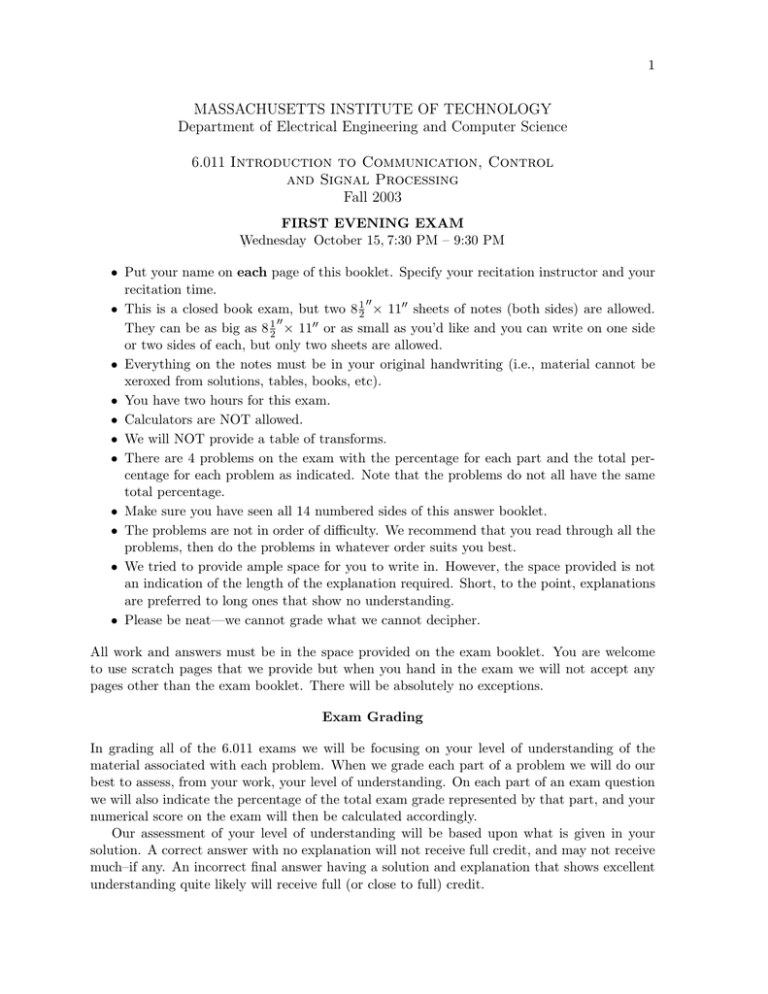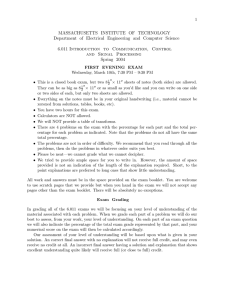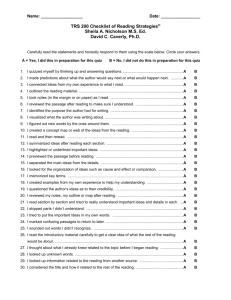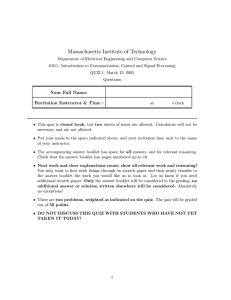MASSACHUSETTS INSTITUTE OF TECHNOLOGY
advertisement

1
MASSACHUSETTS INSTITUTE OF TECHNOLOGY
Department of Electrical Engineering and Computer Science
6.011 Introduction to Communication, Control
and Signal Processing
Fall 2003
FIRST EVENING EXAM
Wednesday
,
October 15, 7:30 PM – 9:30 PM
• Put your name on each page of this booklet. Specify your recitation instructor and your
recitation time.
• This is a closed book exam, but two 8
12 × 11 sheets of notes (both sides) are allowed.
They can be as big as 8 12 × 11 or as small as you’d like and you can write on one side
or two sides of each, but only two sheets are allowed.
• Everything on the notes must be in your original handwriting (i.e., material cannot be
xeroxed from solutions, tables, books, etc).
• You have two hours for this exam.
• Calculators are NOT allowed.
• We will NOT provide a table of transforms.
• There are 4 problems on the exam with the percentage for each part and the total percentage for each problem as indicated. Note that the problems do not all have the same
total percentage.
• Make sure you have seen all 14 numbered sides of this answer booklet.
• The problems are not in order of difficulty. We recommend that you read through all the
problems, then do the problems in whatever order suits you best.
• We tried to provide ample space for you to write in. However, the space provided is not
an indication of the length of the explanation required. Short, to the point, explanations
are preferred to long ones that show no understanding.
• Please be neat—we cannot grade what we cannot decipher.
All work and answers must be in the space provided on the exam booklet. You are welcome
to use scratch pages that we provide but when you hand in the exam we will not accept any
pages other than the exam booklet. There will be absolutely no exceptions.
Exam Grading
In grading all of the 6.011 exams we will be focusing on your level of understanding of the
material associated with each problem. When we grade each part of a problem we will do our
best to assess, from your work, your level of understanding. On each part of an exam question
we will also indicate the percentage of the total exam grade represented by that part, and your
numerical score on the exam will then be calculated accordingly.
Our assessment of your level of understanding will be based upon what is given in your
solution. A correct answer with no explanation will not receive full credit, and may not receive
much–if any. An incorrect final answer having a solution and explanation that shows excellent
understanding quite likely will receive full (or close to full) credit.
2
This page is intentionally left blank. Use it as scratch paper.
No work on this page will be evaluated.
3
MASSACHUSETTS INSTITUTE OF TECHNOLOGY
Department of Electrical Engineering and Computer Science
6.011 Introduction to Communication, Control
and Signal Processing
Fall 2003
FIRST EVENING EXAM
Wednesday, October 15 , 2003
Full Name:
Points
1
2(a)
2(b)
2(c)
2(d)
3(a)
3(b)
3(c)
4(a)
4(b)
4(c)
4(d)
Total
Grader
Full Name:
4
Problem 1 (10%)
The figure below shows three candidates (labeled [A], [B], and [C]) for the autocorrelation
function, Rxx (τ ), of a wide-sense stationary, continuous-time random process x(t).
[A]
R
xx
( τ)
(2)
[B]
(1)
−τ o
R
( ) = impulse area
xx
(1)
0
τo
( τ)
1
τ
[C]
−τ o
0
τo
τ
Rxx ( τ)
1
−τ o
0
τo
τ
For each candidate Rxx (τ ), state whether or not it is a possible autocorrelation function for a
wide-sense stationary random process x(t). Give brief justifications for your answers.
Candidate [A]:
POSSIBLE
NOT POSSIBLE
Candidate [B]:
POSSIBLE
NOT POSSIBLE
Candidate [C]:
POSSIBLE
NOT POSSIBLE
Brief justification:
Full Name:
5
Problem 2 (30%)
Consider a continuous-time random process x(t) defined as follows:
x(t) = cos(ωt + θ),
for −∞ < t < ∞,
where ω and θ are statistically independent random variables, with ω being uniformly distributed on the interval [−ωo , ωo ] and θ being uniformly distributed on the interval [0, 2π].
The triginometric identity below might be helpful:
cos(A) cos(B) =
cos(A + B) + cos(A − B)
.
2
(a) (10%) Determine the following ensemble-average statistics of the random process x(t):
(i) The mean function µx (t) ≡ E[x(t)].
µx (t) =
Work to be looked at:
Full Name:
6
(ii) The correlation function Rxx (t1 , t2 ) ≡ E[x(t1 )x(t2 )].
Rxx (t1 , t2 ) = Work to be looked at:
(b) (10%) Determine in terms of ω and θ the following time averages of a single realization
(outcome) of the random process x(t).
1
x(t) ≡ lim
T →∞ T
x(t + τo )x(t) ≡
1
T →∞ T
�
T /2
x(t) dt
−T /2
�
T /2
lim
(i) x(t) =
Work to be looked at:
−T /2
x(t + τo )x(t) dt,
where τo is a positive constant
Full Name:
(i) cont.
More work to be looked at:
(ii) x(t + τo )x(t) =
Work to be looked at:
7
Full Name:
8
(c) (5%) Is the process wide-sense stationary? Circle your answer and clearly state your
reasoning.
YES
NO
Reasoning:
(d) (5%) Can a really long record of a single realization be used with appropriate time averaging to calculate (at least approximately) Rxx (t1 , t2 )? Circle your answer and clearly
state your reasoning.
YES
Reasoning:
NO
Full Name:
9
Problem 3 (30%)
An A-to-D converter can basically be represented as a C/D converter followed by a quantizer.
As considered in Problem 4.4 (LN 8.7), a useful model for quantization error in a linear quantizer
is to represent the error as a zero-mean i.i.d. process with variance σe2 .
Consequently a useful model for an A/D converter is shown in Figure 3-1.
A/D
e[n]
❄
✲ C/D
✲ +n
x(t)
✻ xd [n]
✲
q[n] = xd [n] + e[n]
T
Figure 3-1:
q[n] represents the quantized signal and e[n] represents the error introduced by quantization.
Assume
1) x(t) is a zero mean WSS random process
2) e[n] is i.i.d, zero-mean, with variance σe2 =
1
5
× 10−3
3) xd [n] and e[n] are statistically independent random processes.
4) The PSD, Sxx (jω), of x(t) is as shown in Figure 3-2.
5) The sampling period is T =
1
4
× 10−5 , i.e. the sampling frequency ωs =
Sxx (jω)
✻
1
❅
❅
❅
−π × 105
❅
π × 105
Figure 3-2: Power spectral density of x(t).
✲
ω
2π
T
= 8π × 105 .
Full Name:
10
(a) (8%) Determine and make a labeled sketch of Sqq (ejΩ ), the PSD of q[n], in the range
|Ω| ≤ 4π.
Sqq (ejΩ )
✻
−4π
−3π
−2π
−π
π
2π
3π
4π
✲
Ω
Sqq (ejΩ ) = Work to be looked at:
(b) (8%) The signal-to-noise ratio, SNRq , of the quantized signal q[n] is defined as:
SNRq �
Determine SNRq .
SNRq =
Work to be looked at:
E{x2d [n]}
E{e2 [n]}
Full Name:
11
(c) (14%) q[n] is now processed as shown in Figure 3-3.
q[n]
✲
✲
H(ejΩ )
r[n] = xr [n] + er [n]
Figure 3-3:
where H(ejΩ ) is the ideal lowpass filter shown in Figure 3-4, xr [n] is due only to xd [n],
and er [n] is due only to e[n].
jΩ )
✻H(e
1
✲
−π
−Ωco
Ωco
π
Ω
Figure 3-4:
2
What value of Ωco would you choose so that Rxr xr [n] = Rxd xd [n] and E{x2
d[n]}/E{er [n]}
(i.e. the SNR after filtering) is maximized. State the maximized SNR value.
Ωco =
Work to be looked at:
maximized SNR=
Full Name:
12
Problem 4 (30%)
Consider the following causal discrete-time state-space system
q[n + 1] = Aq[n] + bx[n]
y[n] = cT q[n] + dx[n]
�
where
A=
1
2
0
3
2
�
2
and b, cT , and d are unknown.
(a) (5%) Determine the eigenvalues λ1 , λ2 and the eigenvectors v1 , v2 of A.
λ1 =
v1 =
λ2 =
v2 =
Work to be looked at:
(b) (7%) Specify all the possible initial conditions (i.e. q[0]) such that the ZIR will decay
asymptotically to zero.
q[0] =
Full Name:
13
(c) (8%) Indicate which, if any, of the following could be ZSR system functions for the system.
(i) H(z) =
z −1
1− 13 z −1
Is it a possible ZSR system function? Circle your answer:
YES
NO
Explanation:
(ii) H(z) =
1+ 12 z −1
1− 12 z −1
Is it a possible ZSR system function? Circle your answer:
YES
Explanation:
NO
Full Name:
14
(d) (10%) We
� want� to describe the system in terms of the new set of state variables
f1 [n]
, where f1 [n] = q1 [n] + q2 [n] and f2 [n] = q1 [n] − q2 [n].
f [n] =
f2 [n]
In other words, we want to describe the system using the following equations:
˜
˜ [n] + bx[n]
f [n + 1] = Af
T
˜
c f [n] + dx[n]
y[n] = ˜
˜ ˜
˜ b,
(i) Determine A,
cT , and d˜ in terms of A, b, cT , and d.
˜=
b
˜ =
A
˜
cT
=
d˜ =
Work to be looked at:
˜nv
˜ n ˜2 ,
(ii) We can express the ZIR of the system in the general form f [n] = α1 λ
1 ˜1 + α2 λ2 v
where α1 and α2 are constants.
˜1, λ
˜2, v
˜1 , and v
˜
2 .
Determine λ
˜1 =
λ
˜2 =
λ
Work to be looked at:
v
˜
1 =
v
˜2 =





